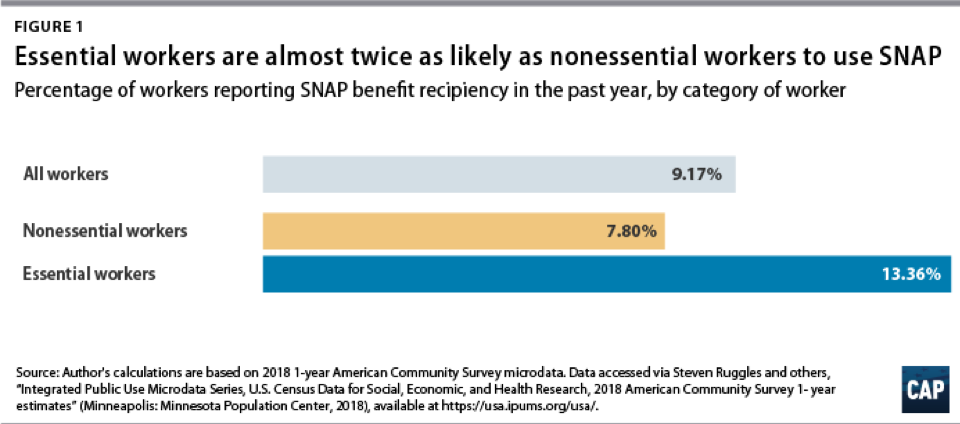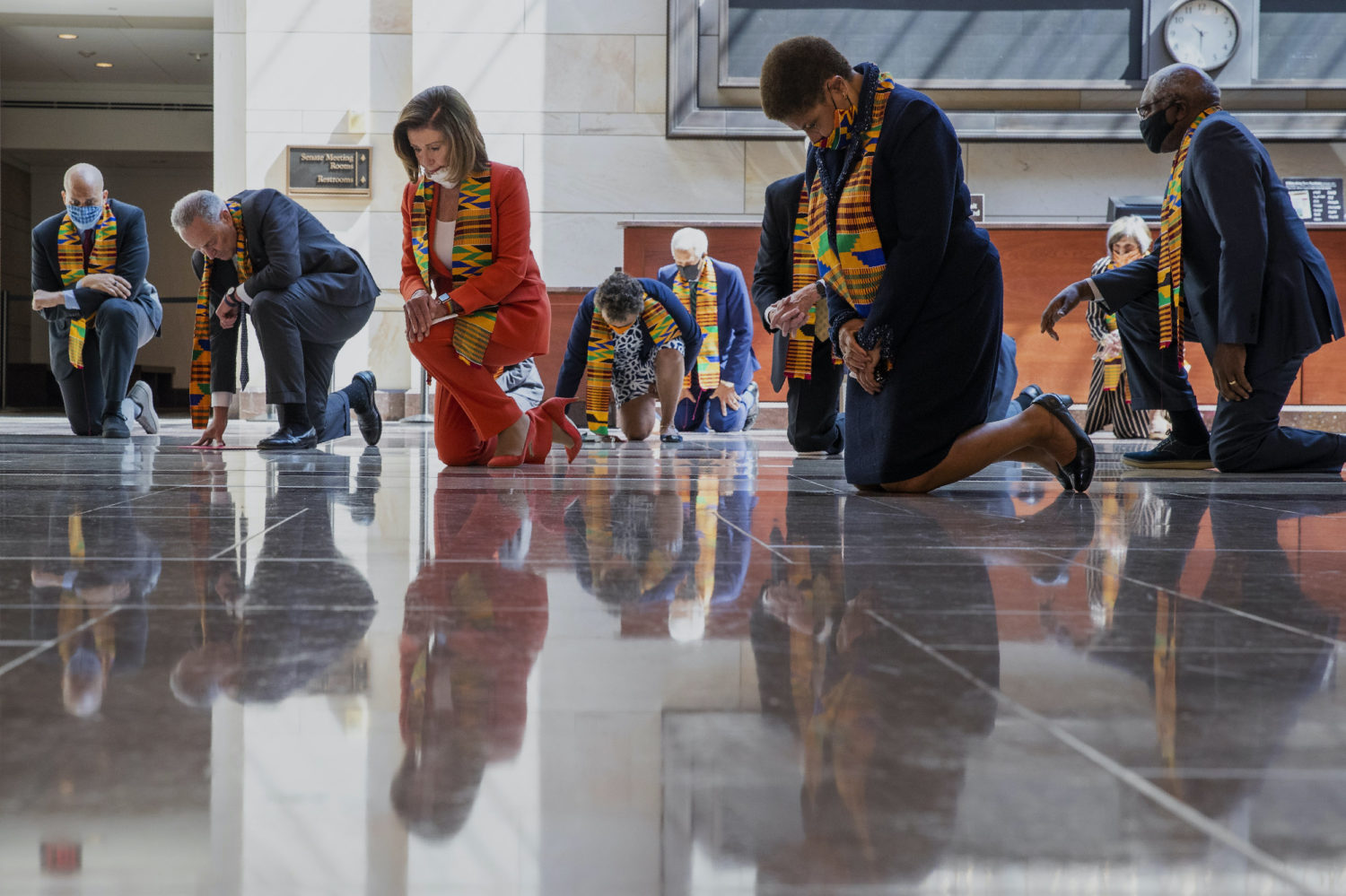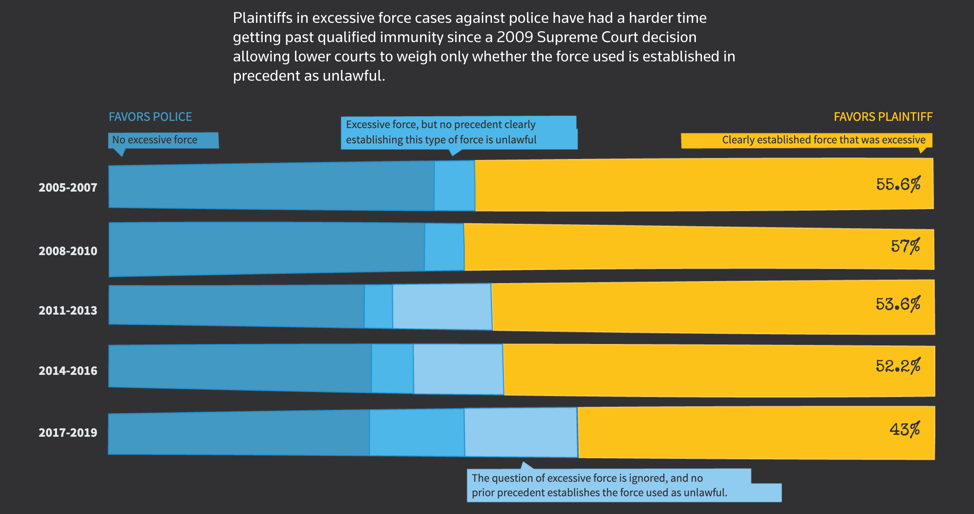 Covering COVID-19 is a daily Poynter briefing of story ideas about the coronavirus and other timely topics for journalists, written by senior faculty Al Tompkins. Sign up here to have it delivered to your inbox every weekday morning.
Covering COVID-19 is a daily Poynter briefing of story ideas about the coronavirus and other timely topics for journalists, written by senior faculty Al Tompkins. Sign up here to have it delivered to your inbox every weekday morning.
A note from Al: I am going to go into a bit of unusual depth on this first item because it is a hot topic that deserves your attention and there are so many local angles for you to explore.
What is ‘qualified immunity’ for police?
Congress is kicking around ideas for reforming police departments. A key sticking point is the notion of “qualified immunity,” a legal doctrine that keeps police officers safe from civil lawsuits. Democrats want to end qualified immunity for police, but Republicans say that idea goes too far.
The central friction is whether it is reasonable to ask police to enforce the law without protection from frivolous lawsuits — while that very protection may enable police to overreact and abuse people without the fear of being sued.
Nearly every year for the last decade, the Supreme Court has taken up at least one case involving qualified immunity for police and nearly always rules in favor of police.
Justices Sonia Sotomayor and Clarence Thomas, on different ends of the political spectrum, have each written about the dangers of qualified immunity. In a 2018 ruling, Sotomayor wrote that with the immunity, police can “shoot first and think later, and it tells the public that palpably unreasonable conduct will go unpunished.” Justice Thomas has said qualified immunity has no historical basis and was invented by judges. In 2017, Justice Thomas wrote about his “growing concern with our qualified immunity jurisprudence.”
Reuters recently published a special report on this issue. Reuters looked at 252 cases from 2015 to 2019 where plaintiffs sought to abolish qualified immunity for the police that they wanted to sue. In about half of those cases, the courts upheld the qualified immunity that protected the officers.
Reuters found that since 2005, the courts have shown “an increasing tendency to grant immunity in excessive force cases.
The two-part test to overcome immunity
Generally, when a plaintiff wants to remove qualified immunity and open a police officer to a civil lawsuit, the plaintiff must meet a two-part test:
- They must show evidence that a jury would be likely to find the officer’s use of force would violate the Fourth Amendment.
- They must show that the officers should have known they were violating “clearly established law.”
The Legal Information Institute at the Cornell Law School offers useful background:
“Qualified immunity balances two important interests—the need to hold public officials accountable when they exercise power irresponsibly and the need to shield officials from harassment, distraction, and liability when they perform their duties reasonably.” Pearson v. Callahan .
Specifically, qualified immunity protects a government official from lawsuits alleging that the official violated a plaintiff‘s rights, only allowing suits where officials violated a “clearly established” statutory or constitutional right. When determining whether or not a right was “clearly established,” courts consider whether a hypothetical reasonable official would have known that the defendant’s conduct violated the plaintiff’s rights. Courts conducting this analysis apply the law that was in force at the time of the alleged violation, not the law in effect when the court considers the case.
Qualified immunity is not immunity from having to pay money damages, but rather immunity from having to go through the costs of a trial at all. Accordingly, courts must resolve qualified immunity issues as early in a case as possible, preferably before discovery.
Qualified immunity only applies to suits against government officials as individuals, not suits against the government for damages caused by the officials’ actions. Although qualified immunity frequently appears in cases involving police officers, it also applies to most other executive branch officials. While judges, prosecutors, legislators, and some other government officials do not receive qualified immunity, most are protected by other immunity doctrines.
[the_ad id=”667826″]
Professional athletes got involved
More than 1,400 former and current MLB, NBA and NFL athletes (see the list), including quarterbacks Tom Brady and Drew Brees, signed a petition supporting the Democratic version of the police reform bill that would end qualified immunity. The athletes wrote:
The Supreme Court has caused irreparable harm to public trust by creating and then expanding the doctrine of qualified immunity, which often exempts police officers and others from liability, even for shocking abuse. Under that doctrine, first developed in 1967 and widened ever since, plaintiffs must show that government officials violated “clearly established” law to receive damages for harm. A plaintiff wins only if a prior Court found an official liable under a nearly identical fact-pattern. This standard is virtually impossible to meet, and the protections promised under section 1983 seem largely symbolic as a result.
Qualified immunity has shielded some of the worst law enforcement officials in America. The 8th Circuit applied it to an officer who wrapped a woman in a bear hug, slammed her to the ground, and broke her collarbone as she walked away from him. The 9th Circuit applied the doctrine to two officers who allegedly stole $225,000 while executing a search warrant. The Eleventh Circuit applied the doctrine to protect an officer who unintentionally shot a 10-year-old while firing at the family dog (who, much like the child, posed no threat). The list of officers who suffered no consequences because of this doctrine could fill a law book.
The legislation that will come this week
Even as Congress is politically divided over this issue, a wide range of political players have lined up in favor of reform. Reuters found many groups — including the American Civil Liberties Union, Cato Institute, NAACP Legal Defense Fund and the conservative Alliance Defending Freedom — are involved in cases fighting qualified immunity for police.
Republicans plan to propose a police reform bill this week, but Republican Sen. Tim Scott of South Carolina said abolishing qualified immunity won’t have enough support to make the final package. The White House said it will not support legislation that removes qualified immunity for police.
Qualified immunity, developed through a handful of Supreme Court rulings, protects police officers from being held personally liable if their actions do not violate a “clearly established” law. There are currently eight cases related to qualified immunity under consideration by the Supreme Court, though justices would need to agree to hear the cases. Justices Clarence Thomas and Sonia Sotomayor have both voiced skepticism about the legal doctrine.
Critics argue that its intent, to protect police officers from frivolous lawsuits, has instead been stretched to make it difficult for someone to sue a police officer even in cases where they believe there are clear examples of excessive force or violations of civil rights.
The Democrat-backed “Justice in Policing Act” includes a ban on chokeholds, a ban on racial profiling and ends “no-knock” warrants. It requires police to wear body cameras and would limit the transfer of military-grade equipment to police departments. It also:
Requires that deadly force be used only as a last resort and requires officers to employ de-escalation techniques first. Changes the standard to evaluate whether law enforcement use of force was justified from whether the force was “reasonable” to whether the force was “necessary.”
But the ban on qualified immunity may be the most controversial part of this sweeping legislation. Read the bill here. Here is what it says:
Section 1979 of the Revised Statutes of the United 16 States (42 U.S.C. 1983) is amended by adding at the end the following: ‘‘It shall not be a defense or immunity to any action brought under this section against a local law enforcement officer (as defined in section 2 of the Justice in Policing Act of 2020) or a State correctional officer (as defined in section 1121(b) of title 18, United States Code) that—‘‘(1) the defendant was acting in good faith, or that the defendant believed, reasonably or otherwise, that his or her conduct was lawful at the time when the conduct was committed; or ‘‘(2) the rights, privileges, or immunities secured by the Constitution and laws were not clearly established at the time of their deprivation by the defendant, or that at this time, the state of the law was otherwise such that the defendant could not reasonably have been expected to know whether his or her conduct was lawful.’’
Local angles
Your local police union will have a lot to say about this issue. Officers will tell you they cannot do their job without some level of protection from lawsuits. Local plaintiff lawyers will tell you about why they don’t take cases involving police abuse because of the high bar they must overcome to avoid the immunity that protects police.
Of course, ask your local members of Congress where they fall on the legislation that is taking shape this week. Get candidates on the record.
There are so many local cases to explore, including a couple that the Supreme Court recently rejected for consideration. Here are links to those, which also contain contact information for the attorneys who are involved:
- (Wymore, Nebraska) Kelsay v. Ernst, U.S., No. 19-682, review denied May 18
- (Fresno, California) Jessop v. City of Fresno, U.S., No. 19-1021, review denied May 18
[the_ad id=”667872″]
Poll: Americans are now OK with national anthem protests
I wanted to be sure you didn’t miss this Yahoo Sports/YouGov poll that just found a big change in American attitudes about sideline protests at NFL games. The poll found:
52% now agree that it is “OK for NFL players to kneel during the national anthem to protest police killings of African Americans.”
The new mask complaint: ‘I am inhaling CO2’
I tripped over this video of a public hearing in Orange County, California. The number of people who complained that wearing a mask was exposing them to carbon dioxide shocked me at a time when so little shocks me.
Then I started to research the question and found people claiming they crashed their cars because the masks they were wearing deprived them of oxygen (why did they have a mask on while driving?).
Let’s start with the understanding that even without a mask you are not breathing 100% pure oxygen. The air you breathe has CO2 in it, about 0.04%. If you get up to about 10% CO2 it can get dangerous. But you need a little bit of CO2 in your blood to regulate your blood pH.
Far from trapping CO2, most masks let in so much air around the edges that they may not offer enough protection against COVID-19. But if you had a really tight-fitting high-quality N-95 mask and wore it for hours non-stop, you could get short of breath due to CO2 (the medical word for it is “hypercapnia”). Health.com turned to experts:
“Someone wearing an N95 mask for a prolonged period of time may have alterations in their blood chemistry that could lead to changes in level of consciousness if severe,” according to infectious disease expert Amesh A. Adalja, M.D., senior scholar at the Johns Hopkins Center for Health Security in Maryland.
Friday, the Centers for Disease Control and Prevention tried again to encourage people who gather in big groups to wear masks.
Why are so many ‘essential workers’ on food stamps?
We say that the people who stock your grocery shelves, take care of your kids in day care and attend to your parents in nursing homes are “essential” during the COVID-19 crisis. But new data from The Center for American Progress found that these very workers are more likely to need SNAP benefits (commonly called food stamps) to get by.
The data makes it more difficult to simultaneously laud these workers and pay them so little while opposing social programs.

(Graphic via Center for American Progress)
We’ll be back tomorrow with a new edition of Covering COVID-19. Sign up here to get it delivered right to your inbox.
[the_ad id=”667878″]
Al Tompkins is senior faculty at Poynter. He can be reached at atompkins@poynter.org or on Twitter, @atompkins.








